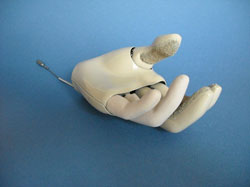Development of prosthetic hands stagnated for twenty years

The Sierra prosthetic hand from 1945 performed better than the newer hands. The inner hand shown in the photo are covered by a cosmetic glove.<br>
High operating force
The study, which was carried out by researchers from TU Delft and the University of Groningen, measured the force required to operate a number of contemporary body-powered prosthetic hands. The researchers compared the results to earlier measurements from 1987 and came up with remarkable results: today’s prosthetic hands perform equally or less well than those from 1987. The grip strength of the hands is insufficient and a very high operating force is required. Another remarkable result: a prosthetic hand developed in 1945 performed better in the test than the newer prosthetic hands.
User overload
TU Delft researcher Gerwin Smit: “The study offers a possible explanation why over half of all people with a body-powered prosthetic hand do not use it or even wear it. Besides this, some prosthetic arm users tend to suffer overload problems over time. These problems may well be a result of the excessive operating force required.” This is currently being researched further in Groningen and Delft.
Electrical alternative?
Worldwide over 30% of prosthesis users wear a body-powered prosthesis. A body-powered prosthesis is operated by pulling a cable (a little like the brake cable on your bike). This cable is attached to a harness worn on the opposite shoulder. Subtle movements between the arm wearing the prosthesis and the opposite shoulder pull the cable taut and open the prosthesis. Another popular prosthesis is the electric prosthesis. This is worn by about 40% of prosthesis users worldwide. Then there are also cosmetic prostheses.
The big question that the researchers raised as a result of this study was why there is hardly any investment in body-powered prostheses. Gerwin Smit: “With current technology it must be possible to easily improve prostheses, resulting in enormous progress for those who have to use them. In recent decades, millions have been invested in electric prostheses. The difference in price between the types of prosthesis may have influenced this, as the retail price of an electric prosthesis is around 10 to 100 time higher than a body-powered prosthesis. This makes it more attractive from a commercial point of view to invest in electric prostheses. Yet despite the investments, electric prostheses are slower and heavier than body-powered prostheses.”
New developments
In order to solve the problems of prosthesis users, TU Delft is working on making improvements to body-powered prosthetic hands. The ultimate aim is to develop a lightweight prosthetic hand with a lower operating force and a higher grip strength.
More information
Gerwin Smit:
Delft Institute of Prosthetics and Orthotics
TU Delft
www.dipo.3me.tudelft.nl
+31 (0)15-2781688
Ilona van den Brink
TU Delft Science Information Officer
+31 (0)15-2784259
Media Contact
More Information:
http://www.tudelft.nlAll latest news from the category: Health and Medicine
This subject area encompasses research and studies in the field of human medicine.
Among the wide-ranging list of topics covered here are anesthesiology, anatomy, surgery, human genetics, hygiene and environmental medicine, internal medicine, neurology, pharmacology, physiology, urology and dental medicine.
Newest articles

Silicon Carbide Innovation Alliance to drive industrial-scale semiconductor work
Known for its ability to withstand extreme environments and high voltages, silicon carbide (SiC) is a semiconducting material made up of silicon and carbon atoms arranged into crystals that is…

New SPECT/CT technique shows impressive biomarker identification
…offers increased access for prostate cancer patients. A novel SPECT/CT acquisition method can accurately detect radiopharmaceutical biodistribution in a convenient manner for prostate cancer patients, opening the door for more…

How 3D printers can give robots a soft touch
Soft skin coverings and touch sensors have emerged as a promising feature for robots that are both safer and more intuitive for human interaction, but they are expensive and difficult…





















